
Vintage postcard, no. 451. Photo: Paramount Films.
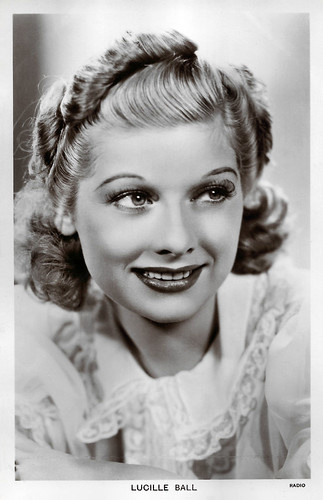
British postcard in the Picturegoer Series, London, no. 1283. Photo: Radio.
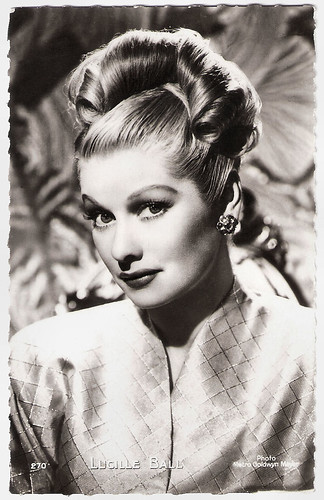
French postcard by Editions P.I., Paris, offered by Les Carbones Multiplane, no. 270. Photo: Clarence Sinclair Bull / Metro-Goldwyn-Mayer, 1945.
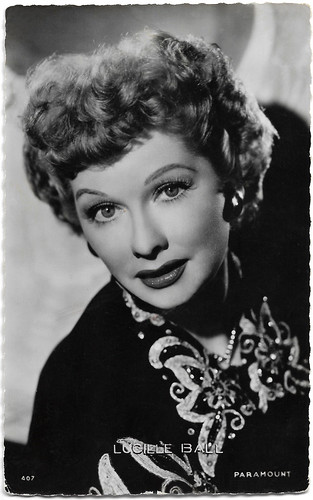
French postcard by Editions P.I., Paris, no. 407. Photo: Paramount Pictures Inc., 1948.
Yearning to make some noice
Lucille Désirée Ball was born in Jamestown, New York, in 1911. Her father was Henry Durrell Ball and her mother Desiree Eve Hunt. Her father died in 1915 before she was four. Lucille and her younger brother Fred were raised by their grandparents while their mother worked several jobs.
Her grandfather was an avid supporter of the theatre and encouraged Lucy to participate in plays at school. Always willing to take responsibility for her brother and young cousins, she was a restless teenager who yearned to "make some noise". She enrolled in the John Murray Anderson School for the Dramatic Arts. There, however, she had a tough competitor who trumped her, Bette Davis. The teachers said she was 'too shy' and had no future and Ball returned home.
In 1932, she moved to New York to become an actress and had success there as a mannequin and revue dancer. But her acting career did not take off till she was chosen to be a "Goldwyn Girl" and appeared in the film Roman Scandals (Frank Tuttle, 1933) starring Eddie Cantor. She was put under contract with RKO Radio Pictures and several bit roles, including one in Top Hat (Mark Sandrich, 1935). She became friends with Ginger Rogers.
In the 1930s she was under contract to RKO and Columbia Pictures and slowly worked her way up from small roles, unnamed in the credits, to more substantial parts. One of her first supporting roles was in Chatterbox (George Nichols Jr., 1936) in which she plays a temperamental actress. It was one of the first times her name was mentioned in the credits. She also got a good role in the A-picture Stage Door (Gregory La Cava, 1937) with Katharine Hepburn and Ginger Rogers. She played more supporting roles, including in Room Service (William A. Seiter, 1938) with the Marx Brothers, but she rarely got leading roles in major films, however, and usually when all the major film stars at RKO had already turned down the part.
In 1940, Lucille Ball met Cuban bandleader-actor, Desi Arnaz, while filming the musical Too Many Girls (George Abbott, 1940). Despite different personalities, lifestyles, religions and ages (he was six years younger), he fell hard, too, and after a passionate romance, they eloped and were married in November 1940. The couple received a lot of media attention. Two years later, Arnaz had to join the army and was unfaithful. A knee injury allowed him to leave the army. In 1944, Ball filed for divorce but later recanted.

French postcard by Editions P.I., Paris, offered by Victoria, Bruxelles/Brussel, no. 270. Photo: Metro-Goldwyn-Mayer. Publicity still for Lured (Douglas Sirk, 1947).

Dutch postcard by MPEA. Sent by mail in 1948. Photo: Clarence Sinclair Bull / Metro-Goldwyn-Mayer.
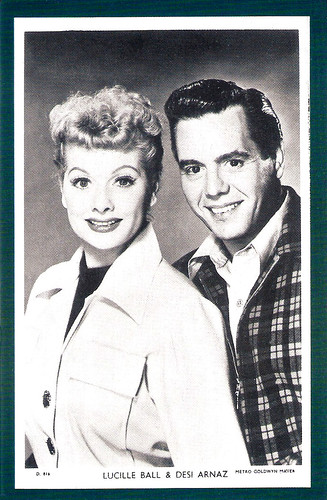
British postcard in the Nostalgia Postcard series by Irish Publishing Ltd, 1981, Set 28, no. D. 816. Photo: Metro Goldwyn Mayer. Lucille Ball and Desi Arnaz.
The most popular and universally beloved sitcom of all time
In the 1940s Lucille Ball moved to Metro-Goldwyn-Mayer, where she got better roles in films such as Du Barry Was a Lady (Roy Del Ruth, 1943) with Red Skelton and Gene Kelly, Best Foot Forward (Edward Buzzell, 1943) and the Katharine Hepburn-Spencer Tracy vehicle Without Love (Harold S. Bucquet, 1945). She failed to achieve major film success there either and returned to Columbia.
She was known in Hollywood circles as the "B-movie queen" with Macdonald Carey as her "king". In 1948, she got a role in the radio comedy 'My Favorite Husband', in which she played the scatterbrained wife of a Midwestern banker. The show became a success and CBS asked her to turn it into a television series. She only wanted to do this if she could work with her husband, and they had creative control over the series. Ball wanted to work with Arnaz to save her marriage.
So I Love Lucy was born, the most popular and universally beloved sitcom of all time. The couple had started their own production company: Desilu Productions. CBS, however, was not impressed with the TV pilot episode, but after Ball and Arnaz toured vaudeville theatre with great success, the series came to television. As a side effect, she practically invented the sitcom and was one of the first stars to film with a live audience.
The show was shot directly to film stock, unlike most other television shows of the time, which used the low-quality kinescope process to film images from a television monitor. The better quality of the Lucy show allowed it to be repeated via syndication (on independent television stations not affiliated with one of the major television networks ABC, CBS or NBC). During the production of I Love Lucy, German-born cameraman Karl Freund invented the "3-camera setup", now standard in television. Another unusual technique used on the Lucy show was to paint over unwanted shadows and hide lighting defects with paint that was kept in the studio in various shades from white to medium grey for this purpose.
In 1951 her first child was born, Lucie Arnaz, followed a year later by Desi Arnaz Jr. The pregnancy was also supposed to be televised but CBS was not in favour of that, eventually, they were allowed to do it but they were not allowed to use the word "pregnant" but had to say "expecting". In 1953, Ball had to appear before the House Committee on Un-American Activities because, at the insistence of her socialist grandfather, she had registered as a supporter of the Communist Party for the 1936 primaries. In 1956, Desilu bought the RKO lot and moved there. In 1957, the last episode of I Love Lucy was aired and was followed by its sequels The Lucy-Desi Comedy Hour (1957-1960) and The Lucy Show (1962-1968), which was later renamed Here's Lucy (1968-1974).
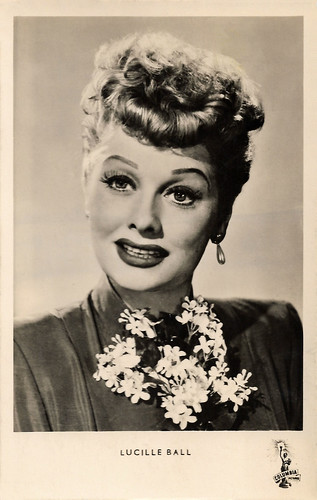
West German postcard by Kunst und Bild, Berlin, no. A 110. Photo: Columbia.
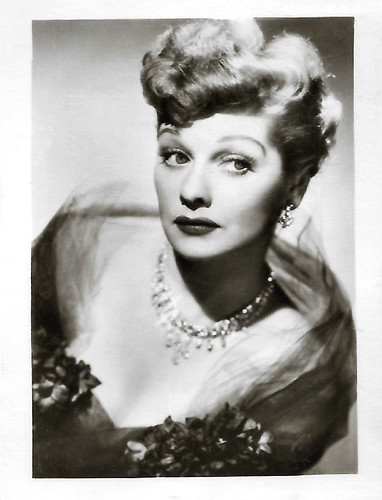
Small German collectors card in the 'Film Stars der Welt ' series by Greiling-Sammelbilder, series C, nr. 111. Photo: Paramount.

Vintage collectors card. Photo: Columbia.
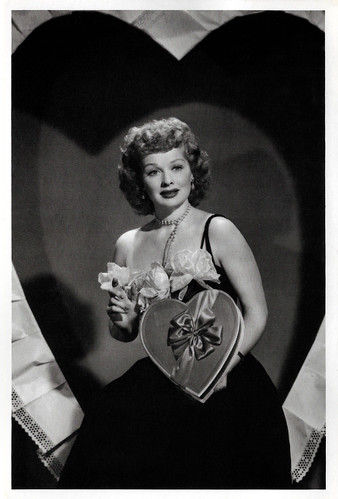
American postcard by The American Postcard Co. Inc., no. 781, 1983.
The sole owner of the studio
In 1960, Lucille Ball and Desi Arnaz's marriage was divorced after problems Arnaz had with alcohol, drugs and other women. Lucille bought his share in Desilu, making her the sole owner of the studio. In the following years, Desilu developed such popular television series as The Untouchables (1959-1963), Star Trek (1966-1969), Mission: Impossible (1966-1973) and Mannix (1967-1975).
In 1967, Desilu was sold to Gulf and Western Industries, which merged Desilu with Paramount Studios, located on the property next door. Arnaz and Ball remained good friends until his death in 1986. In 1961, Ball married stand-up comedy actor Gary Morton who was 12 years younger. He had never seen her on television because he himself performed on primetime when Lucy was on TV. He got a job at Desilu.
After The Lucy-Desi Comedy Hour, Lucille got a series of her own, The Lucy Show (1962-1968) with Gale Gordon and Vivian Vance. It was again a success. Vivian Vance was given the name Viv, which she got because she was tired of being addressed as Ethel on the street. In 1968, after Lucille sold Desilu, she founded Lucille Ball Production. Lucille's third sitcom was Here's Lucy (1968-1974), played with her real children, Lucie Arnaz and Desi Arnaz Jr. Also in this series, Gale Gordon was her co-star.
After I Love Lucy, Lucille starred in several more films including Yours, Mine, and Ours (Melville Shavelson, 1968) with Henry Fonda, the musical Mame (Gene Saks, 1974) and the TV movie Stone Pillow (George Schaefer, 1985). In 1986, she made a comeback with the series Life with Lucy, but it flopped with critics and viewers alike. After playing for less than two months, the series was cancelled by ABC.
Lucille Ball was a guest on several shows. In 1989 at the 61st Academy Awards, she presented the Academy Awards with Bob Hope, she then received a standing ovation. A month later in 1989, Lucille Ball died of aortic dissection at the age of 77. She was buried in Forest Lawn - Hollywood Hills Cemetery in Los Angeles but was later moved by her children, Desi Arnaz Jr. and Lucie Arnaz, to Lake View Cemetery in her native Jamestown.

American postcard by Bizzaro, Greenville, RI, no. 02828, 1990. Lucille Ball, Desi Arnaz and Vivian Vance in the TV series I Love Lucy (1951-1957).

American postcard by the American Postcard Company Inc. (AP), no. 723, 1983. Photo: CBS. Lucille Ball in the episode Sales resistance #45 (1953) of the TV series I Love Lucy (1951-1957).
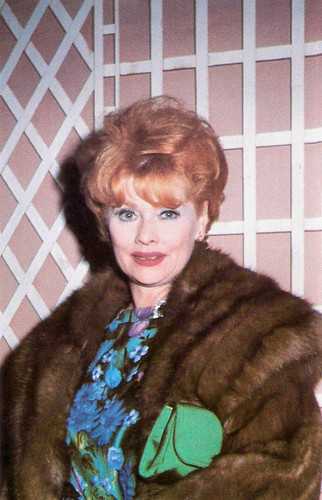
American postcard by Coral-Lee, Rancho Cordova, CA, no. CL-Personality # 59-1980 C33289. Photo: Luke Juhasz.
Source: Wikipedia (Dutch, German and English) and IMDb.
No comments:
Post a Comment